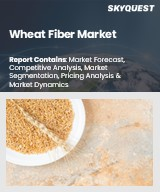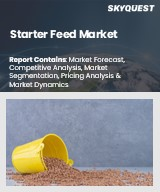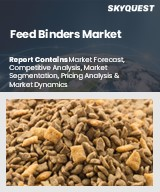
|
시장보고서
상품코드
1604561
세계의 밀 시장 : 예측(2025-2030년)Global Wheat Market - Forecasts from 2025 to 2030 |
||||||
세계의 밀 시장은 10.16%의 CAGR로 성장하며, 2025년 2,351억 8,800만 달러에서 2030년에는 3,814억 8,500만 달러데 달할 것으로 추정됩니다.
밀은 벼과 식물로 주로 종자를 위해 전 세계에서 재배되고 있습니다. 밀은 전 세계 인구 대부분이 소비하는 가장 흔한 곡물 중 하나입니다. 밀은 탄수화물, 비타민, 미네랄의 가장 흔한 공급원 중 하나입니다. 또한 탄수화물 함량이 높기 때문에 섭취시 에너지가 많아 체중 조절에 도움이 됩니다. 또한 통밀을 섭취하면 심혈관 질환의 위험을 낮출 수 있습니다.
밀 씨앗은 다양한 용도로 사용되며 일반적으로 식품 및 음료 분야에서 사용됩니다. 밀 씨앗은 밀가루와 밀가루를 생산하기 위해 갈아서 밀가루와 세미 리나를 생산합니다. 경질 적색 봄밀, 연질 백밀, 경질 밀 등 다양한 밀 품종이 전 세계에서 재배되고 있습니다. 경질 적색 봄밀은 주로 북미에서 재배되며, 연질 백밀은 높은 파단율과 스트레이트 등급의 밀가루 수율을 제공합니다. 회분이 적고 전분 손상이 적습니다.
세계 밀 시장은 세계 밀 생산량 증가에 따라 수요가 크게 증가할 것으로 예상됩니다. 중국, 인도, EU, 러시아는 밀 재배에서 가장 큰 생산국 중 하나이며 전 세계 밀의 절반 이상을 생산하고 있습니다. 마찬가지로 밀 제품의 건강 효과에 대한 소비자의 인식이 높아지는 것도 세계 시장 규모를 확대하는 데 도움이 될 것으로 추정됩니다.
세계 밀 시장 성장 촉진요인
- 세계 밀 생산량 증가
세계 밀 시장을 촉진하는 주요 요인은 세계 밀 생산량 증가입니다. 밀은 가장 일반적으로 생산되는 식용 곡물 중 하나이며 전 세계 거의 모든 지역에서 생산됩니다. 밀에 대한 세계 수요가 크게 증가하고 있습니다. 미국 농무부는 보고서에서 지난 수년간 세계 밀 생산량이 크게 증가했다고 밝혔습니다. 농무부에 따르면 EU는 2022년에 약 1억 3,429만 2,000톤의 밀을 생산하고 2023년에는 1억 3,486만 5,000톤으로 증가할 것으로 예상했습니다. 마찬가지로 인도의 밀 생산량은 2022년 1억 4천만 톤에서 2023년 약 1억 1,055만 4,000톤으로 증가했습니다.
USDA는 또한 밀 생산은 주로 유럽과 아시아 지역에 집중되어 있으며, 중국, EU, 인도, 러시아가 연간 세계 밀의 대부분을 생산하고 있다고 밝혔습니다. 중국, EU, 인도는 전 세계 밀 생산량의 약 48%를 차지하고 있습니다. 이 기관에 따르면 2023-24 회계연도에는 중국과 EU가 세계 밀 생산량의 약 17%, 인도와 러시아가 각각 약 14%와 12%를 차지할 것으로 예상했습니다.
세계 밀 시장의 지역적 전망
- 세계 밀 시장에서 유럽연합(EU)이 큰 비중을 차지할 것으로 예상됩니다.
유럽연합은 다른 어떤 선진국보다 더 많은 밀 생산량을 늘릴 것으로 예상됩니다. 선진국과 달리 신흥 국가은 2029년까지 세계 생산량에 36Mt을 추가할 것으로 예상되며, 세계 생산량에서 차지하는 비중은 소폭 증가할 것으로 예상되며, EU는 농가의 안정적인 소득을 보장하는 최저지지 가격 정책으로 인해 밀 생산량이 증가할 것으로 예상됩니다. 국산 하이브리드 종자와 비료의 조합, 낮은 에너지 비용, 대규모 상업 농장, 양질의 토양이 러시아와 우크라이나의 생산량 증가에 기여했습니다.
이 보고서를 구매해야 하는 이유
- 인사이트 분석 : 고객 부문, 정부 정책 및 사회경제적 요인, 소비자 선호도, 산업별, 기타 하위 부문에 중점을 두고 주요 지역뿐만 아니라 신흥 지역까지 포괄하는 상세한 시장 인사이트를 얻을 수 있습니다.
- 경쟁 환경: 세계 주요 기업이 채택하고 있는 전략적 전략을 이해하고, 적절한 전략을 통한 시장 침투 가능성을 파악할 수 있습니다.
- 시장 성장 촉진요인과 미래 동향 : 역동적인 요인과 매우 중요한 시장 동향, 그리고 이들이 향후 시장 발전을 어떻게 형성할 것인지에 대해 알아봅니다.
- 행동 가능한 제안: 역동적인 환경 속에서 새로운 비즈니스 스트림과 매출을 발굴하기 위한 전략적 의사결정에 인사이트을 활용합니다.
- 다양한 사용자에 대응: 스타트업, 연구기관, 컨설턴트, 중소기업, 대기업에 유익하고 비용 효율적입니다.
어떤 용도로 사용되는가?
산업 및 시장 검토, 사업 기회 평가, 제품 수요 예측, 시장 진출 전략, 지역적 확장, 설비 투자 결정, 규제 프레임워크 및 영향, 신제품 개발, 경쟁의 영향
분석 범위
- 과거 데이터 및 예측(2022-2030년)
- 성장 기회, 과제, 공급망 전망, 규제 프레임워크, 고객 행동 및 동향 분석
- 경쟁사 포지셔닝, 전략 및 시장 점유율 분석
- 매출 성장률 및 예측 분석 : 부문별, 지역별(국가별)
- 기업 프로파일링(전략, 제품, 재무정보, 주요 동향 등)
목차
제1장 서론
- 시장 개요
- 시장 정의
- 분석 범위
- 시장 세분화
- 통화
- 전제조건
- 기준년과 예측년 타임라인
- 이해관계자에 대한 주요 이점
제2장 분석 방법
- 분석 디자인
- 분석 프로세스
제3장 개요
- 주요 조사 결과
제4장 시장 역학
- 시장 성장 촉진요인
- 시장 성장 억제요인
- Porter's Five Forces 분석
- 업계 밸류체인 분석
- 애널리스트의 견해
제5장 세계의 밀 시장 : 유형별
- 서론
- Hard Red Wheat
- Hard Red Spring
- Soft Red Wheat
- Soft White
- Hard Wheat
제6장 세계의 밀 시장 : 용도별
- 서론
- 소맥분
- 밀알
제7장 세계의 밀 시장 : 최종사용자별
- 서론
- 가정용
- 상업용/산업용
제8장 세계의 밀 시장 : 지역별
- 서론
- 북미
- 유형별
- 용도별
- 최종사용자별
- 국가별
- 남미
- 유형별
- 용도별
- 최종사용자별
- 국가별
- 유럽
- 유형별
- 용도별
- 최종사용자별
- 국가별
- 중동 및 아프리카
- 유형별
- 용도별
- 최종사용자별
- 국가별
- 아시아태평양
- 유형별
- 용도별
- 최종사용자별
- 국가별
제9장 경쟁 환경과 분석
- 주요 기업과 전략 분석
- 시장 점유율 분석
- 기업인수합병(M&A), 합의, 사업 협력
- 경쟁 대시보드
제10장 기업 개요
- Shri Mahavir Agritech(Mahavir Group Inc.)
- Shyali Products Private Limited
- ADM(Archer Daniels Midland)
- Cargill, Inc
- Adani Wilmar(Adani Group)
- Manildra Group
- PureField
- General Mills Inc
- VAD industries
- Jay Jay Agro
- Ambe Group
- Sarwa Foods
- Gold Grain(India) Pvt. Ltd.
- Maeda Foods Co., Ltd
- Kumamoto Flour Milling Co., Ltd.
The global wheat market is estimated to grow at a CAGR of 10.16%, from US$235.188 billion in 2025 to US$381.485 billion in 2030.
Wheat is a type of grass that is cultivated worldwide mainly for its seed. It is among the most common cereal consumed by the majority of the global population. Wheat is among the most common sources of carbohydrates, vitamins, and minerals. The cereal also offers a higher amount of energy on consumption, as it has a higher quantity of carbohydrates, and can help in managing weight. The consumption of whole wheat also lowers the risk of cardiovascular diseases.
The wheat seed is used for multiple applications, commonly in the food and beverage sector. The wheat seeds are grinded for producing wheat flour or semolina. Various wheat varieties are cultivated worldwide, including hard red spring, soft white, hard wheat, and others. Hard red spring wheat is mainly cultivated in the North American region, whereas soft white wheat offers a high break and straight-grade flour yield. It contains lower ash and low starch damage.
The global wheat market is estimated to witness substantial growth in demand, majorly with the increasing wheat production worldwide. In the cultivation of wheat, China, India, the EU, and Russia are among the biggest producers, producing more than half of the global wheat. Similarly, the increasing consumer perception of wheat products' health benefits is also estimated to increase its market size globally.
Global wheat market drivers
- Increasing production of wheat across the globe
A major factor propelling the global wheat market is the increasing wheat production globally. Wheat is among the most commonly produced food grains, and it is produced in almost every region globally. The global demand for wheat witnessed a major increase. The US Department of Agriculture, in its report, stated that the global production of wheat grew significantly over the past few years. The agency stated that in the European Union, about 134,292 thousand tons of wheat were produced in 2022, which increased to 134,865 thousand tons in 2023. Similarly, in India, wheat production increased from 104,000 thousand tons in 2022 to about 110,554 thousand tons in 2023.
USDA further stated that the production of wheat is majorly concentrated in the European and Asian regions, with China, the EU, India, and Russia producing the majority of the global wheat annually. China, the EU, and India alone occupy about 48% of the global production share of wheat. The agency stated that in the 2023-24 financial year, China and the EU occupied about 17% of the global wheat production, whereas India and Russia contributed about 14% and 12%, respectively, each in the same year.
Global wheat market geographical outlook
- The European Union is forecasted to hold a major share of the global wheat market.
European Union is expected to grow wheat production more than any other developed country. In contrast to the developed countries, developing countries are projected to add 36 Mt to global output by 2029, representing a marginal increase in their share of global production. EU is projected to increase its wheat production largely due to its minimum support price policy, which guarantees farmers a stable income. A combination of domestically produced hybrid seeds and fertilizers, low energy costs, large commercial farms, and good soil contributed to Russian and Ukrainian production increases.
Reasons for buying this report:-
- Insightful Analysis: Gain detailed market insights covering major as well as emerging geographical regions, focusing on customer segments, government policies and socio-economic factors, consumer preferences, industry verticals, other sub- segments.
- Competitive Landscape: Understand the strategic maneuvers employed by key players globally to understand possible market penetration with the correct strategy.
- Market Drivers & Future Trends: Explore the dynamic factors and pivotal market trends and how they will shape up future market developments.
- Actionable Recommendations: Utilize the insights to exercise strategic decision to uncover new business streams and revenues in a dynamic environment.
- Caters to a Wide Audience: Beneficial and cost-effective for startups, research institutions, consultants, SMEs, and large enterprises.
What do businesses use our reports for?
Industry and Market Insights, Opportunity Assessment, Product Demand Forecasting, Market Entry Strategy, Geographical Expansion, Capital Investment Decisions, Regulatory Framework & Implications, New Product Development, Competitive Intelligence
Report Coverage:
- Historical data & forecasts from 2022 to 2030
- Growth Opportunities, Challenges, Supply Chain Outlook, Regulatory Framework, Customer Behaviour, and Trend Analysis
- Competitive Positioning, Strategies, and Market Share Analysis
- Revenue Growth and Forecast Assessment of segments and regions including countries
- Company Profiling (Strategies, Products, Financial Information, and Key Developments among others)
The Global Wheat Market is segmented and analyzed as follows:
By Type
- Hard Red Wheat
- Hard Red Spring
- Soft Red Wheat
- Soft White
- Hard Wheat
By Uses
- Flour
- Grain
By End-User
- Household
- Commercial/Industrial
By Geography
- North America
- USA
- Canada
- Mexico
- South America
- Brazil
- Argentina
- Others
- Europe
- Germany
- France
- United Kingdom
- Italy
- Spain
- Others
- Middle East and Africa
- Saudi Arabia
- UAE
- Israel
- Others
- Asia Pacific
- China
- Japan
- South Korea
- India
- Thailand
- Taiwan
- Indonesia
- Others
TABLE OF CONTENTS
1. INTRODUCTION
- 1.1. Market Overview
- 1.2. Market Definition
- 1.3. Scope of the Study
- 1.4. Market Segmentation
- 1.5. Currency
- 1.6. Assumptions
- 1.7. Base and Forecast Years Timeline
- 1.8. Key benefits for the stakeholders
2. RESEARCH METHODOLOGY
- 2.1. Research Design
- 2.2. Research Process
3. EXECUTIVE SUMMARY
- 3.1. Key Findings
4. MARKET DYNAMICS
- 4.1. Market Drivers
- 4.2. Market Restraints
- 4.3. Porter's Five Forces Analysis
- 4.3.1. Bargaining Power of Suppliers
- 4.3.2. Bargaining Power of Buyers
- 4.3.3. The Threat of New Entrants
- 4.3.4. Threat of Substitutes
- 4.3.5. Competitive Rivalry in the Industry
- 4.4. Industry Value Chain Analysis
- 4.5. Analyst View
5. GLOBAL WHEAT MARKET BY TYPE
- 5.1. Introduction
- 5.2. Hard Red Wheat
- 5.3. Hard Red Spring
- 5.4. Soft Red Wheat
- 5.5. Soft White
- 5.6. Hard Wheat
6. GLOBAL WHEAT MARKET BY USES
- 6.1. Introduction
- 6.2. Flour
- 6.3. Grain
7. GLOBAL WHEAT MARKET BY END-USER
- 7.1. Introduction
- 7.2. Household
- 7.3. Commercial/Industrial
8. GLOBAL WHEAT MARKET BY GEOGRAPHY
- 8.1. Introduction
- 8.2. North America
- 8.2.1. By Type
- 8.2.2. By Uses
- 8.2.3. By End-User
- 8.2.4. By Country
- 8.2.4.1. United States
- 8.2.4.2. Canada
- 8.2.4.3. Others
- 8.3. South America
- 8.3.1. By Type
- 8.3.2. By Uses
- 8.3.3. By End-User
- 8.3.4. By Country
- 8.3.4.1. Brazil
- 8.3.4.2. Argentina
- 8.3.4.3. Others
- 8.4. Europe
- 8.4.1. By Type
- 8.4.2. By Uses
- 8.4.3. By End-User
- 8.4.4. By Country
- 8.4.4.1. Germany
- 8.4.4.2. France
- 8.4.4.3. United Kingdom
- 8.4.4.4. Spain
- 8.4.4.5. Others
- 8.5. Middle East and Africa
- 8.5.1. By Type
- 8.5.2. By Uses
- 8.5.3. By End-User
- 8.5.4. By Country
- 8.5.4.1. Saudi Arabia
- 8.5.4.2. UAE
- 8.5.4.3. Israel
- 8.5.4.4. Others
- 8.6. Asia Pacific
- 8.6.1. By Type
- 8.6.2. By Uses
- 8.6.3. By End-User
- 8.6.4. By Country
- 8.6.4.1. China
- 8.6.4.2. India
- 8.6.4.3. South Korea
- 8.6.4.4. Taiwan
- 8.6.4.5. Thailand
- 8.6.4.6. Indonesia
- 8.6.4.7. Japan
- 8.6.4.8. Others
9. COMPETITIVE ENVIRONMENT AND ANALYSIS
- 9.1. Major Players and Strategy Analysis
- 9.2. Market Share Analysis
- 9.3. Mergers, Acquisitions, Agreements, and Collaborations
- 9.4. Competitive Dashboard
10. COMPANY PROFILES
- 10.1. Shri Mahavir Agritech (Mahavir Group Inc.)
- 10.2. Shyali Products Private Limited
- 10.3. ADM (Archer Daniels Midland)
- 10.4. Cargill, Inc
- 10.5. Adani Wilmar (Adani Group)
- 10.6. Manildra Group
- 10.7. PureField
- 10.8. General Mills Inc
- 10.9. VAD industries
- 10.10. Jay Jay Agro
- 10.11. Ambe Group
- 10.12. Sarwa Foods
- 10.13. Gold Grain (India) Pvt. Ltd.
- 10.14. Maeda Foods Co., Ltd
- 10.15. Kumamoto Flour Milling Co., Ltd.



















